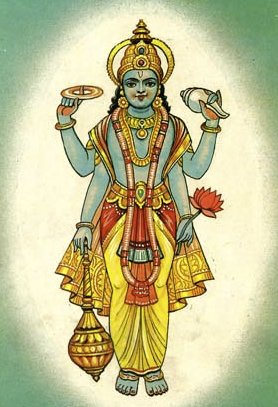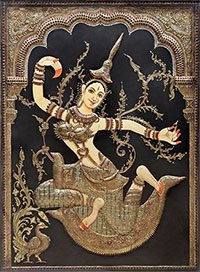Pancashara, Pañcaśara, Pañcasāra, Pancasara, Pāñcaśara, Pancan-shara: 17 definitions
Introduction:
Pancashara means something in Buddhism, Pali, Hinduism, Sanskrit, Jainism, Prakrit. If you want to know the exact meaning, history, etymology or English translation of this term then check out the descriptions on this page. Add your comment or reference to a book if you want to contribute to this summary article.
The Sanskrit terms Pañcaśara and Pāñcaśara can be transliterated into English as Pancasara or Pancashara, using the IAST transliteration scheme (?).
Alternative spellings of this word include Panchashara.
In Hinduism
Purana and Itihasa (epic history)
Source: Cologne Digital Sanskrit Dictionaries: The Purana IndexPañcaśara (पञ्चशर).—An epithet of the God of love; his dart is the twig of the mango, and his standard, the fish; his wife, Ratī and his friend, Madhu or the spring; also Pañcabāṇa and Madana.*
- * Matsya-purāṇa 154. 207-9, 212.

The Purana (पुराण, purāṇas) refers to Sanskrit literature preserving ancient India’s vast cultural history, including historical legends, religious ceremonies, various arts and sciences. The eighteen mahapuranas total over 400,000 shlokas (metrical couplets) and date to at least several centuries BCE.
Ayurveda (science of life)
Kalpa (Formulas, Drug prescriptions and other Medicinal preparations)
Source: Shodhganga: Edition translation and critical study of yogasarasamgrahaPañcasāra refers to a medicinal recipe mentioned in the Lehakhaṇḍa (verse 8.1) of the 15th-century Yogasārasaṅgraha (Yogasara-saṅgraha) by Vāsudeva: an unpublished Keralite work representing an Ayurvedic compendium of medicinal recipes. The Lehakhaṇḍa [mentioning pañcasāra] contains preparations of leha (linctus, i.e. medicine in the form of a syrup), āsava and gula; such recipes treat patients suffering from conditions such as intermittent fever, cough, hiccough, fever, dyspnoea, haemorrhagic diseases, pulmonary cavitation, tuberculosis, etc.
Unclassified Ayurveda definitions
Source: archive.org: Vagbhata’s Ashtanga Hridaya Samhita (first 5 chapters)Pañcasāra (पञ्चसार) refers to “five essences”, and represents a type of drink-preparation, mentioned in verse 3.31 of the Aṣṭāṅgahṛdayasaṃhitā (Sūtrasthāna) by Vāgbhaṭa.—Accordingly, “[...] One shall drink broth (that is) not too thick, rasālā, curds, raga and khāṇḍava syrup, or from clay shells, a five-essence [viz., pañcasāra] potion (that is) kept in a new vessel, mixed with small banana and coco-nut pieces, (and) acidulated, [...]”.
Note: Pānaka has been interchanged with its attribute pañcasāra and the following vā left untranslated. Yet it is not likely that the first pāda ran “pānakaṃ pañcasārdāhyaṃ” in the basic test, which (according to the apparatus critieus of K) is the reading of all manuscripts but one. Indu adduces another Nighaṇṭu-śloka:—“Prepared from grapes, mahua fruits, liquorice, jujubes, and pomegranates, the potion called ‘five essences’ [viz., pañcasāra] (is) eliminative of heat and thirst”.

Āyurveda (आयुर्वेद, ayurveda) is a branch of Indian science dealing with medicine, herbalism, taxology, anatomy, surgery, alchemy and related topics. Traditional practice of Āyurveda in ancient India dates back to at least the first millenium BC. Literature is commonly written in Sanskrit using various poetic metres.
Vaishnavism (Vaishava dharma)
Source: Acta Orientalia vol. 74 (2013): Historical sequence of the Vaiṣṇava DivyadeśasPañcasāra is short for Pañcasārakṣetra (Cēṟai), which refers to one of the 108 Vaishnava Divya Desam (divyadeśas or divyasthalas), located in the topographical division of Cōḻanāṭu (“Chola country”), according to the 9th century Nālāyirativviyappirapantam (shortly Nālāyiram).—Tradition would record the Vaiṣṇava divyadeśas or divyasthalas are 108. The divyadeśa is a base of the cult of Viṣṇu in Viṣṇuism [Vaiṣṇavism] tradition. The list of 108 [viz., Pañcasārakṣetra] seems to have reached maturation by about the early 9th century CE as all the deśas are extolled in the hymns of the twelve Āḻvārs.

Vaishnava (वैष्णव, vaiṣṇava) or vaishnavism (vaiṣṇavism) represents a tradition of Hinduism worshipping Vishnu as the supreme Lord. Similar to the Shaktism and Shaivism traditions, Vaishnavism also developed as an individual movement, famous for its exposition of the dashavatara (‘ten avatars of Vishnu’).
Shaivism (Shaiva philosophy)
Source: Brill: Śaivism and the Tantric TraditionsPañcaśara (पञ्चशर) refers to “five (glowing) arrows”, according to the 13th-century Matsyendrasaṃhitā: a Kubjikā-Tripurā oriented Tantric Yoga text of the Ṣaḍanvayaśāmbhava tradition from South India.—Accordingly, “[Visualisation of Parameśvara]:—[...] He is in the prime of his youth and has all the auspicious characteristics. He has the great Ajagava bow placed on his left side. On his right, he has five glowing arrows (ujjvalat-pañcaśara). He is shining like a blue lotus. On his chest there is a glittering garland of blue lotuses. He is the Lord. [...]”.

Shaiva (शैव, śaiva) or Shaivism (śaivism) represents a tradition of Hinduism worshiping Shiva as the supreme being. Closely related to Shaktism, Shaiva literature includes a range of scriptures, including Tantras, while the root of this tradition may be traced back to the ancient Vedas.
Sports, Arts and Entertainment (wordly enjoyments)
Source: archive.org: Syainika Sastra of Rudradeva with English Translation (art)Pañcasāra (पञ्चसार) refers to “five elixirs of life”, according to the Śyainika-śāstra: a Sanskrit treatise dealing with the divisions and benefits of Hunting and Hawking, written by Rājā Rudradeva (or Candradeva) in possibly the 13th century.—Accordingly, “Hunting on horseback (āśvina) represents one of the eight subdivisions of Hunting (mṛgayā). [...] The very life and soul of sexual enjeyment are pride, the self-importance, and pleasure. Therefore for one fatigued with hunting are prescribed, the plaster of sandal paste and other things, the shampooing by the leaf-like soft hands of women, syrups, the five elixirs of life (pañcasāra), and fanning with palm-leaves. [...]”.

This section covers the skills and profiencies of the Kalas (“performing arts”) and Shastras (“sciences”) involving ancient Indian traditions of sports, games, arts, entertainment, love-making and other means of wordly enjoyments. Traditionally these topics were dealt with in Sanskrit treatises explaing the philosophy and the justification of enjoying the pleasures of the senses.
In Buddhism
Mahayana (major branch of Buddhism)
Source: De Gruyter: A Buddhist Ritual Manual on AgriculturePañcaśara (पञ्चशर) [=śarapañcaka?] refers to “five arrows” (suitable for an offering ceremony), according to the Vajratuṇḍasamayakalparāja, an ancient Buddhist ritual manual on agriculture from the 5th-century (or earlier), containing various instructions for the Sangha to provide agriculture-related services to laypeople including rain-making, weather control and crop protection.—Accordingly, [as the Bhagavān teaches the offering manual of the root-heart] “[...] Five arrows (śarapañcaka) and a trident should be driven into the ground. Four arrows should be wound round entirely with five-coloured twine. Four filled jars, four ladles with frankincense and four jars of offering should be placed. One filled with white offerings should be placed in the middle of the maṇḍala. [...]”.

Mahayana (महायान, mahāyāna) is a major branch of Buddhism focusing on the path of a Bodhisattva (spiritual aspirants/ enlightened beings). Extant literature is vast and primarely composed in the Sanskrit language. There are many sūtras of which some of the earliest are the various Prajñāpāramitā sūtras.
In Jainism
General definition (in Jainism)
Source: academia.edu: Tessitori Collection IPañcāsara (पञ्चासर) is the name of a temple, according to the Pañcāsarapārśvanātha (dealing with Pārśva in Jain literature), which is included in the collection of manuscripts at the ‘Vincenzo Joppi’ library, collected by Luigi Pio Tessitori during his visit to Rajasthan between 1914 and 1919.—The Pañcāsar (Pañcāsara) Pārśvanātha temple, in Patan, was got to be constructed by Vanarāja when the new capital Anahillapura was founded in 746 CE. Pañcāsar is the name of a village to the southwest of the town which was the native place of Vanarāja. This temple is an extremely important sacred place.

Jainism is an Indian religion of Dharma whose doctrine revolves around harmlessness (ahimsa) towards every living being. The two major branches (Digambara and Svetambara) of Jainism stimulate self-control (or, shramana, ‘self-reliance’) and spiritual development through a path of peace for the soul to progess to the ultimate goal.
Languages of India and abroad
Sanskrit dictionary
Source: DDSA: The practical Sanskrit-English dictionaryPañcaśara (पञ्चशर).—epithets of the god of love; (so called because he has five arrows; their names are:-aravindamaśokaṃ ca cūtaṃ ca navamallikā | nīlotpalaṃ ca pañcaite pañcabāṇasya sāyakāḥ || the five arrows are also thus named:-saṃmohanonmādanau ca śoṣaṇastāpanastathā | stambhanaśceti kāmasya pañcabāṇāḥ prakīrtitāḥ ||).
Derivable forms: pañcaśaraḥ (पञ्चशरः).
Pañcaśara is a Sanskrit compound consisting of the terms pañcan and śara (शर). See also (synonyms): pañceṣu, pañcabāṇa.
--- OR ---
Pañcaśara (पञ्चशर).—epithets of the god of love; see पञ्चेषु (pañceṣu).
Derivable forms: pañcaśaraḥ (पञ्चशरः).
Pañcaśara is a Sanskrit compound consisting of the terms pañcan and śara (शर). See also (synonyms): pañcabāṇa, pañcavāṇa.
Source: Cologne Digital Sanskrit Dictionaries: Shabda-Sagara Sanskrit-English DictionaryPañcaśara (पञ्चशर).—m.
(-raḥ) Kamadeva. E. pañca five, and śara an arrow: see the last.
Source: Cologne Digital Sanskrit Dictionaries: Benfey Sanskrit-English DictionaryPañcaśara (पञ्चशर).—(having five arrows), m. Kāma, [Prabodhacandrodaya, (ed. Brockhaus.)] 72, 11.
Pañcaśara is a Sanskrit compound consisting of the terms pañcan and śara (शर).
Source: Cologne Digital Sanskrit Dictionaries: Cappeller Sanskrit-English DictionaryPañcaśara (पञ्चशर).—[masculine] = pañcabāṇa.
Source: Cologne Digital Sanskrit Dictionaries: Aufrecht Catalogus CatalogorumPañcasāra (पञ्चसार) as mentioned in Aufrecht’s Catalogus Catalogorum:—vedānta. Oppert. Ii, 3416.
—by Śaṅkara Bhaṭṭa. Oppert. Ii, 8887.
1) Pañcaśara (पञ्चशर):—[=pañca-śara] [from pañca] m. = -bāṇa, [Prabodha-candrodaya] (f(ī). = -bāṇī, [Naiṣadha-carita])
2) Pañcasāra (पञ्चसार):—[=pañca-sāra] [from pañca] mfn. consisting of 5 parts or ingredients, [Suśruta]
3) [v.s. ...] n. (?) Name of [work]
4) Pāñcaśara (पाञ्चशर):—[=pāñca-śara] [from pāñca] mf(ī)n. belonging to the (5-arrowed) god of love, [Kathāsaritsāgara]
Source: Cologne Digital Sanskrit Dictionaries: Yates Sanskrit-English DictionaryPañcaśara (पञ्चशर):—[pañca-śara] (raḥ) 1. m. Idem.
[Sanskrit to German]
Sanskrit, also spelled संस्कृतम् (saṃskṛtam), is an ancient language of India commonly seen as the grandmother of the Indo-European language family (even English!). Closely allied with Prakrit and Pali, Sanskrit is more exhaustive in both grammar and terms and has the most extensive collection of literature in the world, greatly surpassing its sister-languages Greek and Latin.
See also (Relevant definitions)
Partial matches: Sara, Cara, Panca.
Starts with: Pancasharadiya, Pancasharanirnaya, Pancasharava, Pancasharavijaya, Pancasharavyakhya.
Full-text: Pancasharavijaya, Pancasharanirnaya, Pancasharavyakhya, Prapancasara, Prapancasaraviveka, Prapancasarasarasamgraha, Pancasala, Kusumashara, Todara, Pancavana, Pancabana, Sara, Panceshu, Anahilla, Anahillapura, Ujjvalat, Sharapancaka, Shankara bhatta, Apeksha, Pattra.
Relevant text
Search found 8 books and stories containing Pancashara, Pañcaśara, Pancan-sara, Panca-shara, Pañca-śara, Pañcasāra, Panca-sara, Pañca-sāra, Pancasara, Pāñcaśara, Pancan-shara, Pañcan-śara, Pāñca-śara, Pañcāsara; (plurals include: Pancasharas, Pañcaśaras, saras, sharas, śaras, Pañcasāras, sāras, Pancasaras, Pāñcaśaras, Pañcāsaras). You can also click to the full overview containing English textual excerpts. Below are direct links for the most relevant articles:
Bhakti-rasamrta-sindhu (by Śrīla Rūpa Gosvāmī)
Verse 3.5.17 < [Part 5 - Conjugal Love (mādhurya-rasa)]
Amarakoshodghatana of Kshirasvamin (study) (by A. Yamuna Devi)
Gods and Divinities < [Chapter 4 - Cultural Aspects]
Puranic encyclopaedia (by Vettam Mani)
Jainism in Odisha (Orissa) (by Ashis Ranjan Sahoo)
Jain Architecture (Introduction) < [Chapter 4]
Sushruta Samhita, Volume 6: Uttara-tantra (by Kaviraj Kunja Lal Bhishagratna)
Chapter XXXIX - Symptoms and Treatment of Fever (Jvara) < [Canto III - Kaya-chikitsa-tantra (internal medicine)]
The Agni Purana (by N. Gangadharan)